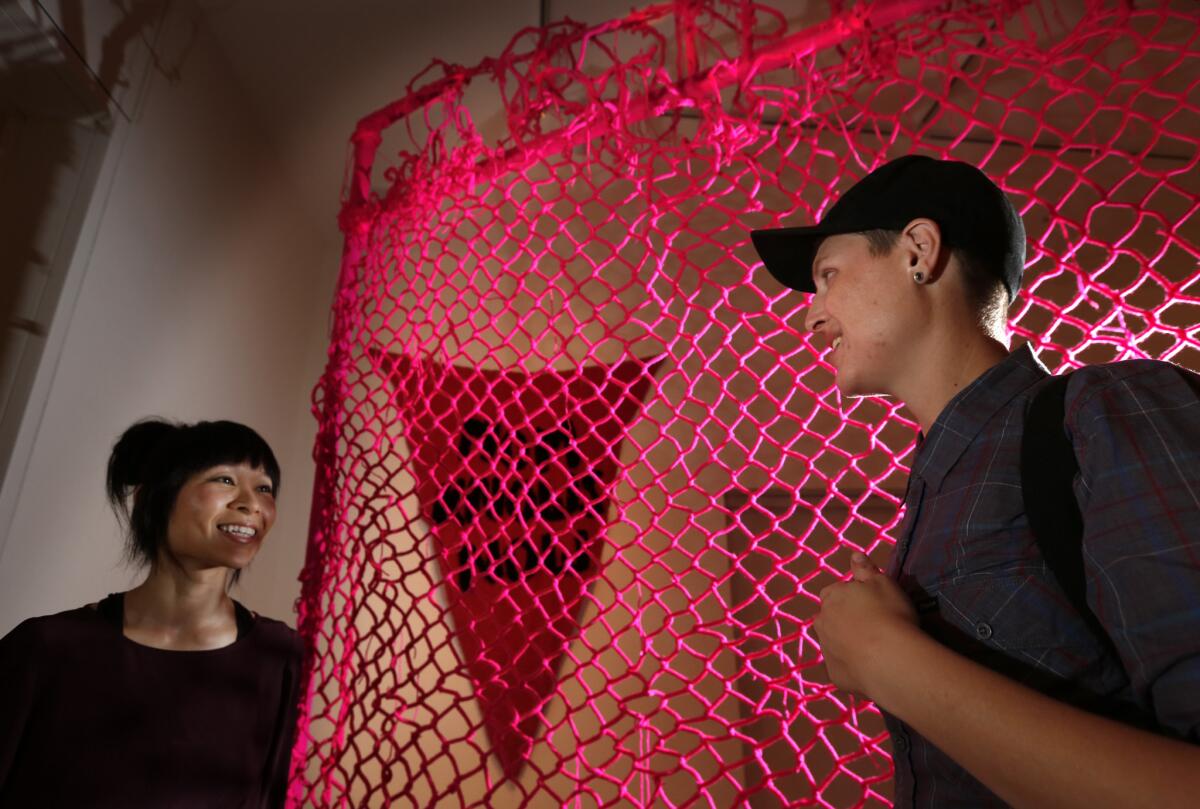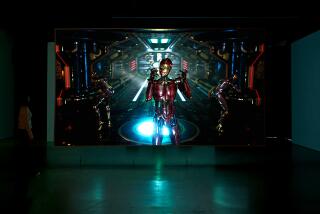Riot Grrrls stake a new space in ‘Alien She’

Astria Suparak, curator of the exhibition Alien She, chats with artist LJ Roberts standing next to the crank-knit yarn, hand-woven wire, steel poles hardware piece titled “We Couldn’t Get In. We Couldn’t Get Out” at the Orange County Museum of Art in Newport Beach.
The lesbian feminist sasquatches conspire in a far corner of the room.
Some crouch and sniff, others tower on massive feet, their stout legs covered with thick fur. Made from thrift-store-sourced textiles, including toilet and car seat covers, bath mats and pillow shams, the curious creatures are the work of Toronto artist Allyson Mitchell. They are part of a group show at the Orange County Museum of Art called “Alien She,” which curators say is the first to examine the past, present and future of the underground punk feminist movement known as Riot Grrrl.
Riot Grrrl catalyzed a generation of women to move from analyzing and consuming culture to actively producing it. “Alien She,” curated by Astria Suparak and Ceci Moss, traces the lineage of the movement from its roots to its current incarnation as a platform for social justice in a world muddied by prejudice of all kinds.
The exhibition focuses on the work of seven artists deeply influenced by the movement and includes nearly 900 historical and contemporary art objects, including zines, posters, mix tapes, sculptures, films, videos, collages and photos. The show is not meant to be a historical document but rather a snapshot of the past 20 years with an eye to the future and the challenges faced by the marginalized.
That’s the point of Mitchell’s “Ladies Sasquatch.”
“They are this feral, nonassimilated representation of femininity,” Mitchell says. “They’re not two white women standing in front of a white picket fence, married and paying their taxes. They’re raw and nasty with giant fangs and claws and engorged vulvas that are coming to get ya.”
Riot Grrrl crept out of the alternative culture ethos in the early 1990s, beginning in Washington, D.C., and the Pacific Northwest and spreading with a slow, urgent burn around the globe. It was defined by its independent spirit and its all-inclusive nature, with an emphasis on social justice and female empowerment. Music was a bedrock of the movement, and bands such as Bikini Kill, Huggy Bear and Sleater-Kinney came to define its sound. It has, and still does, tackle issues and ideas about race, class, queer culture, the environment, skateboarding, mental illness and body dysmorphia.
In its early years, poised on the brink of the digital revolution, it was known for the DIY, analog dissemination of its ideas and values. Cut-and-paste zines that were photocopied and distributed by hand were a staple of the movement and, along with its vibrant music and arts scene, served as Riot Grrrl’s primary means of communication. As an evolving organism of activism and change, Riot Grrrl has moved into the digital ether and onto Pinterest, Tumblr, Instagram and Facebook. Although its biggest concerns have remained much the same, contemporary aspects of injustice such as cyber bullying and a perceived increase in college campus rape are now addressed.
“Every person we knew who was involved with Riot Grrrl in the ‘90s are all artists, musicians, educators or activists today,” says Suparak, who joined the movement as a teen in Los Angeles. “I think it’s fascinating that we’ve all formed our identities and careers as adults, but that was such an important and transformative moment for us.”
The Newport Beach museum show includes the textile-based work of L.J. Roberts, an artist who identifies with neither the “he” nor “she” pronoun but employs the gender-neutral “they.” Standing in front of a giant pink fence that Roberts made using hand-dyed fabric and children’s toy knitting machines as well as a large pink flag emblazoned with the words “Mom Knows Now,” Roberts discusses a troubled past that led to an activist present.
“The first time I verbally outed myself I was probably 14 or 15,” says the artist, 34. “I was taken to boarding school and given coercion therapy and a feminine program specifically tailored for me.”
In college Roberts lived in a radical environmental cooperative. The artist unfurled the “Mom Knows Now” flag in a guerrilla banner drop from the steeple of the Ira Allen Chapel at the University of Vermont while a student there in 2003.
This kind of grass-roots activism is common in Riot Grrrl. Mitchell started an activist group in the ‘90s with the goal of interrupting traditional messages about what bodies are supposed to look like.
“We would dress up in really loud outfits and walk around in a fashion district asking people if they thought we were fat,” says Mitchell, now an assistant professor in the women’s studies school at York University. “It was emotionally exhausting, but I learned through the process how effective that kind of thing can be.”
Mitchell is working on a touring feminist haunted house called Kill Joy’s Kastle inside of which gay performers enact the greatest fears that people have about gay people.
“The real monsters of lesbian feminism that won’t die,” Mitchell says, citing archetypes that seem particularly uncomfortable to the mainstream. “The polyamorous vampire granny and the gender studies professor dance party.”
Does taking a movement that is by its very definition anti-establishment and hyper nonconformist and presenting it within the walls of a mainstream museum dilute the message?
Quite the opposite, says artist Stephanie Syjuco, whose work includes tear-off tab fliers with URLs to unsanctioned downloads of critical and philosophical literature including “Culture & Imperialism” by Edward W. Said and “T.A.Z: The Temporary Autonomous Zone, Ontological Anarchy, Poetic Terrorism” by Hakim Bey.
“Twenty years later, the potential held in its embeddedness is a point of strength,” she says. “It’s active, but it’s evolving.”
Syjuco is an assistant professor of sculpture at UC Berkeley and says she looks at her students, searching for the punks and radicals. She knows they are there, even though she might not recognize them.
“Things just look different,” she says. “It’s great, it’s a moving target.”
Another participant in “Alien She” who seeks to hit that moving target with precision is Miranda July, the avant-garde filmmaker and writer. Inspired by Riot Grrrl in the ‘90s, July started a video chain letter for female filmmakers called “Joanie 4 Jackie,” which via fliers and zines encouraged women and girls to mail their videos to her. In exchange, she would send them their video back on a VHS tape featuring nine other videos that had been submitted along with the addresses of the filmmakers so the women involved could stay in touch.
Portions of that project are featured in “Alien She,” along with new work by July, who Suparak says comfortably and easily adapts to new technology that draws in young converts.
Her latest work, also featured in the exhibition, is culled from the participatory website Learning to Love You More, along with the mobile app Somebody, which encourage visitors to submit “assignments” such as “Write down a recent argument” or “photograph a significant outfit.”
“This is what I was wearing the first time (and thus far, the only time) I had sex with a girl, and finally admitted to myself that I might be (probably am) a lesbian,” reads the caption beside a picture of a black lace tank top and a checked pair of underwear with red trim.
The photo was sent by an anonymous woman in Muncie, Ind. Evidence of yet another Riot Grrrl being born.
More to Read
The biggest entertainment stories
Get our big stories about Hollywood, film, television, music, arts, culture and more right in your inbox as soon as they publish.
You may occasionally receive promotional content from the Los Angeles Times.







